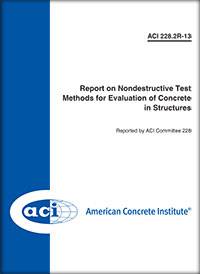L'American Concrete Institute pubblica il Report sui NDT alle opere in calcestruzzo
Sul sito dell'ACI è possibile acquistare l'ultimo report sui Metodi non distruttivi (NDT) per la valutazione del calcestruzzo nelle strutture
Sul sito dell'ACI (American Concrete Institute) è possibile acquistare l'ultimo report sui Metodi non distruttivi (NDT) per la valutazione del calcestruzzo nelle strutture.
Di seguito si riporta un breve abstract e le indicazioni per l'acquisto del documento.
228.2R-13: Report on Nondestructive Test Methods for Evaluation of Concrete in Structures

Autore: Comitato ACI 228
Anno di pubblicazione: 2013
Numero di pagine: 82
Abstract
Il presente documento rappresenta una revisione sui Metodi di prova non distruttivi utilizzati per valutare il calcestruzzo e le armature di acciaio nelle strutture.
I metodi comprendono l'ispezione visiva, lo stresswave, le prove nucleari, la misurazione delle proprietà di trasporto dei fluidi, le prove magnetiche ed elettriche, la termografia a infrarossi e ground-penetrating radar. Nel documento vengono trattati i principi che stanno alla base di ogni metodo e descritte le tipiche strumentazioni utilizzate. Vengono descritte tutte le varie procedure e spiegati i metodi di analisi dei dati. Evidenziati i vantaggi e i limite di ogni singolo metodo. Il report infine si conclude con la trattazione di una pianificazione di un programma di NDT.
Presenti ulteriori informazioni generali per coloro che hanno il compito di valutare le condizioni di una struttura in cemento armato e che valutano l'applicabilità di metodi non distruttivi come strumento complementare a tale valutazione.
A review is presented of nondestructive test (NDT) methods for evaluating the condition of concrete and steel reinforcement in structures. Methods discussed include visual inspection, stresswave, nuclear, measurement of fluid transport properties, magnetic and electrical, infrared thermography, and ground-penetrating radar. The principle of each method is discussed and the typical instrumentation described. Testing procedures are summarized and the data analysis methods explained. The advantages and limitations of the methods are highlighted. This report concludes with a discussion of planning a NDT program. General information is provided for those faced with the task of evaluating the condition of a concrete structure and who are considering the applicability of NDT methods to aid in that evaluation.
Contents
CHAPTER 1—INTRODUCTION, p. 2
1.1—Scope, p. 2
1.2—Needs and applications, p. 2
1.3—Objective, p. 2
CHAPTER 2—NOTATION AND DEFINITIONS, p. 2
2.1—Notation, p. 2
2.2—Definitions, p. 3
CHAPTER 3—SUMMARY OF METHODS, p. 3
3.1—Visual inspection, p. 5
3.2—Stress-wave methods for structures, p. 6
3.3—Low strain stress-wave methods for deep foundations,p. 17
3.4—Nuclear methods, p. 23
3.5—Magnetic and electrical methods, p. 28
3.6—Methods for measuring transport properties, p. 44
3.7—Infrared thermography, p. 51
3.8—Radar, p. 53
CHAPTER 4—PLANNING AND PERFORMING NONDESTRUCTIVE TESTING INVESTIGATIONS,p. 61
4.1—Selection of methods, p. 61
4.2—Defining scope of investigation, p. 62
4.3—Numerical and experimental simulations, p. 66
4.4—Correlation with intrusive testing, p. 71
4.5—Reporting results, p. 71
CHAPTER 5—REFERENCES, p. 71
APPENDIX A: THEORETICAL ASPECTS OF MOBILITY PLOT OF PILE, p. 81
Per acquistare il report
Phone: 248-848-3800, and mention order code 228213.EM
Click: Report on Nondestructive Test Methods for Evaluation of Concrete in Structures
Per ulteriori info
American Concrete Institute
Phone: 248-848-3800
E-mail: bkstore@concrete.org
Online: www.concrete.org



